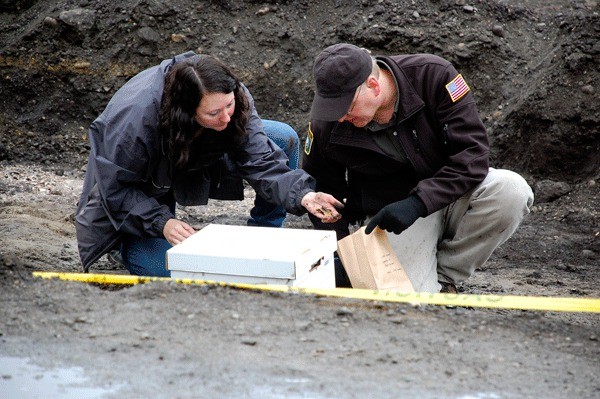State experts who visited downtown Oak Harbor Saturday were able to answer two big questions about human remains unearthed on SE Pioneer Way late last week.
“We know that there are at least three individuals and that they are Native American,” said Allyson Brooks, director of the Department of Archaeology and Historic Preservation in Olympia.
According to Brooks, the examination of skull fragments and the placement of bones within the excavation site made it clear to the visiting anthropologist that the remains are not those of early European settlers.
The remains were discovered early Thursday morning, June 16, by a backhoe operator who was excavating a section of roadway in front of Mike’s Mini Mart. Work on that part of the construction project, which is turning SE Pioneer Way into an eastbound one-way, was stopped immediately.
Police and the county coroner spent the morning examining the bones. They determined that while the bones were human, this was not the scene of a crime. The state historic preservation office was contacted. The section of the street was closed down and placed guard until experts from the office could inspect the site in person.
Also put under surveillance was a dump site on Pit Road. Additional bones were found in about nine piles of dirt that came from the section of roadway excavated in front of Mike’s Mini Mart.
The experts that came out Saturday, physical anthropologist Guy Tasa and Assistant State Archeologist Gretchen Kaehler, spent several hours at each site. At the time, Tasa said he could not release details about what they found, but did say he would be sending his findings to 11 different tribes on Monday.
Western Washington tribes have certain areas that are of particular interest to them whenever suspected Native American remains are found, said Tasa, and Whidbey Island is a hotspot.
“It’s one of the areas with the highest number of tribes I would notify,” he said.
According to Brooks, the next step is to begin a dialogue with the affected tribes in an effort to establish identity and what should be done with the remains. They can be left where they are or removed; it’s a decision that has yet to be made, she said.
“That’s something the city and tribes will have to discuss,” Brooks said.
Saturday’s examination also narrowed down the boundaries of the archeological site. Initially, nearly an entire block was cordoned off but Tasa gave the go-ahead to reduce the closure significantly and a lane of traffic was reopened at about 12:30 p.m. Saturday.
“That was a big relief,” City Engineer Eric Johnston said.
By closing down the whole block, the construction site was essentially split in half, which restricted work crews ability to move heavy equipment from one side of the project area to the other. Had the closure persisted, it would have severely impacted both efficiency and productivity, Johnston said.
As for the overall project schedule, it’s still too soon to know how or if it will be affected. Like everyone else, Johnston said the city will just have to wait to see what the tribes and the historic preservation office decide.



